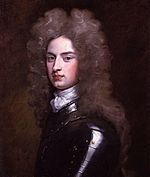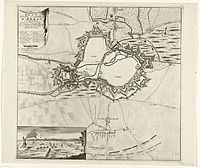Bombardment of Arras facts for kids
Quick facts for kids Bombardment of Arras |
|||||||
|---|---|---|---|---|---|---|---|
| Part of the War of the Spanish Succession | |||||||
 A 1712 print depicting the bombardment |
|||||||
|
|||||||
| Belligerents | |||||||
| Commanders and leaders | |||||||
| Strength | |||||||
| 36 battalions 44 squadrons c. 17,400 men 22 guns and mortars |
Unknown | ||||||
| Casualties and losses | |||||||
| 20 killed or wounded | |||||||
The Bombardment of Arras was a military attack that happened on March 2 and 3, 1712. It was part of a bigger war called the War of the Spanish Succession. An army of Allied forces, led by Earl of Albemarle, attacked the city of Arras in France. Their goal was to destroy important supplies stored there. This would make it harder for the French army to fight back. The attack was a success, but the Allies couldn't fully use their advantage. This was because some important troops arrived too late.
Contents
Why Arras Was Attacked
The year 1712 started with problems among the Allied forces. These were the countries fighting against France in the War of the Spanish Succession. In Britain, a political group called the Tories had taken power. They replaced another group called the Whigs.
The Tories believed the war was too expensive. They also thought that the Whigs and their general, Duke of Marlborough, were getting rich from it. Because of this, Queen Anne removed Marlborough from his position. He had been leading the Allied armies in the Low Countries since 1702.
The Tories also had disagreements with their Dutch allies. A writer named Jonathan Swift wrote that the Dutch were not grateful. He said they were a threat to England. The British government even said the Dutch had not kept their promises about sending soldiers. The Dutch leaders, like Anthonie Heinsius, strongly disagreed. They wrote a detailed reply that made the British government look bad.
Secret Peace Talks Begin
Despite these arguments, the Tories secretly started talking about peace with France. To keep their allies unaware, and to have a stronger position in peace talks, Britain decided to join a new military campaign in 1712.
Duke of Ormonde was chosen to lead the British troops. He had some experience, but the British government could control him easily. Ormonde was secretly told to make the Allied war efforts difficult. This was meant to make the Dutch and the Holy Roman Emperor want peace more.
However, the Dutch leaders did not want Ormonde to lead their soldiers. They asked the Emperor to send his general, Eugene of Savoy, back to the Netherlands. The Emperor agreed and also sent 20,000 more soldiers.
Planning the Attack
The year before, the Duke of Marlborough had captured a town called Bouchain. He left many soldiers in border towns. This stopped the French from building up their defenses during winter.
In January, a plan was made in The Hague. The idea was to burn a large French hay storage in Arras. This would stop the French army from moving early in the year. If the supplies were destroyed, Eugene could attack Arras or Cambrai without a large French army stopping him. Earl of Albemarle, a Dutch general, was chosen to lead this mission to Arras.
The Bombardment Begins
In February, Albemarle started his plan. He had 36 battalions (groups of soldiers) and 44 squadrons (groups of cavalry). Generals Hompesch, Grovestins, and Cadogan supported him. Albemarle made the French think he was going to attack along the Sambre river.
Instead, he ordered soldiers from several towns to move towards Douai. There, they would cross the Scarpe river towards Arras. About 2,000 workers also joined this force.
On March 1, Albemarle's army left at 4 PM for Arras. They crossed the Scarpe at Fampoux in the evening. After marching all night, they arrived near Arras at 4 AM on March 2.
Setting Up the Attack
Once there, Albemarle ordered the workers to dig trenches. They also built two artillery batteries (places for cannons). This was done so quickly that the French commander in Arras, Pierre de Montesquiou d'Artagnan, didn't realize the city was surrounded. He only found out when local farmers brought the news.
D'Artagnan immediately tried to attack Bapaume, a part of Arras taken by the Allies. But his attack failed. Albemarle had to wait for his heavy cannons to arrive. They got there at 11 AM, but the bombing didn't start until 5 PM. Bombs and glowing cannonballs were fired into the city.
The attack was very effective. Around 11 PM, the hay, straw, and other supplies caught fire. These supplies were in 36 large piles between the city and the citadel (a strong fortress). A large wood storage also burned down.
The fire created burning dust. This made the French commander and the citizens worried. They feared the fire might spread to the citadel's arsenal. If the gunpowder there caught fire, it could destroy the entire city. So, D'Artagnan quickly moved the gunpowder to safer places.
Albemarle continued the bombing until 3 AM the next morning. He had achieved his goal of destroying the supplies. One hour before dawn, he ordered the cannons to be pulled back. The rest of the army left at 8 AM, with flags flying and trumpets blowing. They then returned to their original towns.
What Happened Next
The mission was a clear success. About 1 to 1.2 million food rations and other supplies had been burned. Albemarle wrote to the Dutch leaders:
'The fear this attack has caused among the enemies is unbelievable. It stops them from gathering their army before they can get food from the land. This means we can start an early and good campaign.'
However, Albemarle was disappointed. This advantage could not be used. The 20,000 soldiers promised by the Emperor did not arrive until mid-May. By then, the French general, Villars, had already gathered his army. So, the Allies' campaign in 1712 became difficult.
Ormonde's Secret Orders
First, Ormonde began to cause problems for the campaign. He refused to agree to any plans that Eugene and the Dutch suggested. The British government had secretly told the French about this. Ormonde admitted he had "restraining orders" from the British government. This put pressure on the British government. They told their allies that Ormonde had misunderstood his orders. They then allowed Ormonde to join the siege of Le Quesnoy.

Not long after, the situation changed again. In June, Ormonde was ordered to take his troops back to Flanders. However, 25,000 to 30,000 German and Danish soldiers working for Britain refused to leave. They told the Dutch leaders that they would stay with the Allied army. They would only leave if their own rulers told them to. The Dutch promised to pay for their upkeep.
Even without the British troops, the Allies could continue their attack. The siege of Le Quesnoy went well for them.
The End of the War
However, the Allies were defeated at the Battle of Denain. This allowed Villars to recapture Le Quesnoy and other French fortresses. This happened before the armies went into winter camps. The path to Paris became impossible for the Allies. The Dutch then decided it was time to accept the peace offers from France and Britain.
On April 11, 1713, the Peace of Utrecht was signed. This treaty ended the war for many countries. The Emperor continued fighting until 1714. He made peace in the Peace of Rastatt.
Sources




